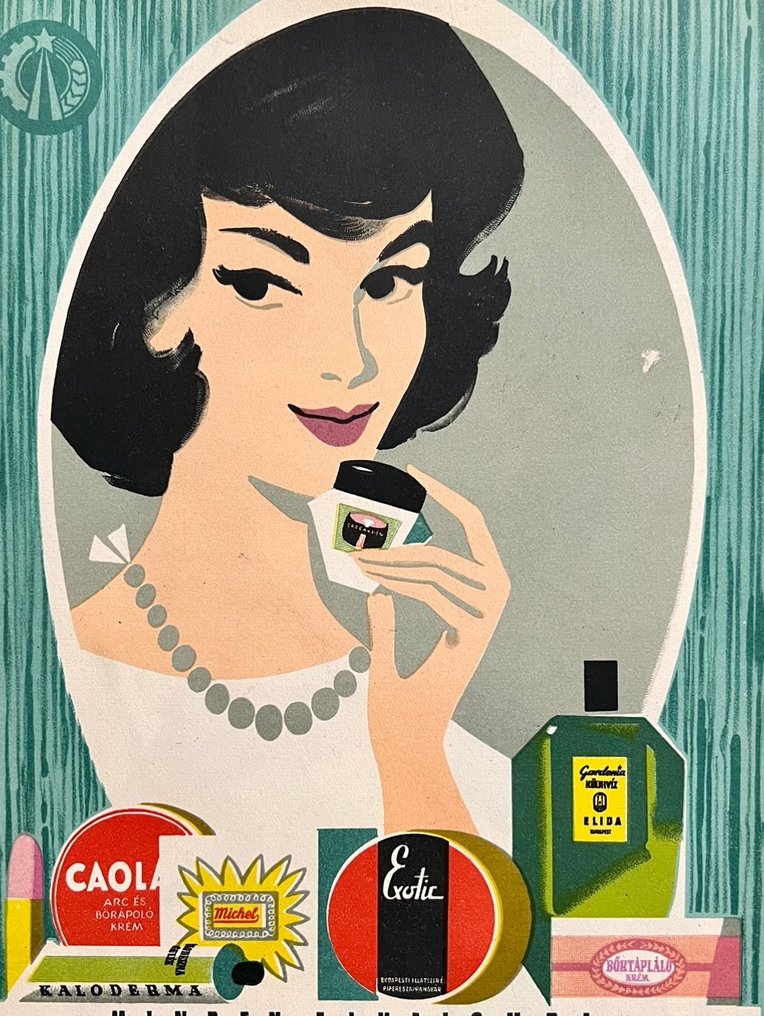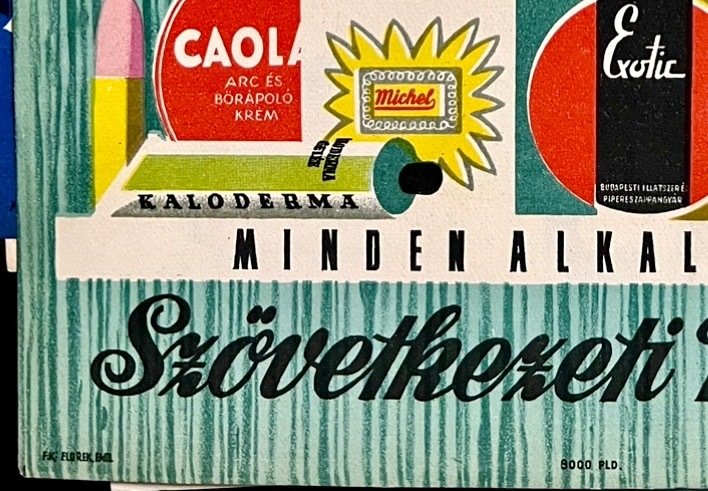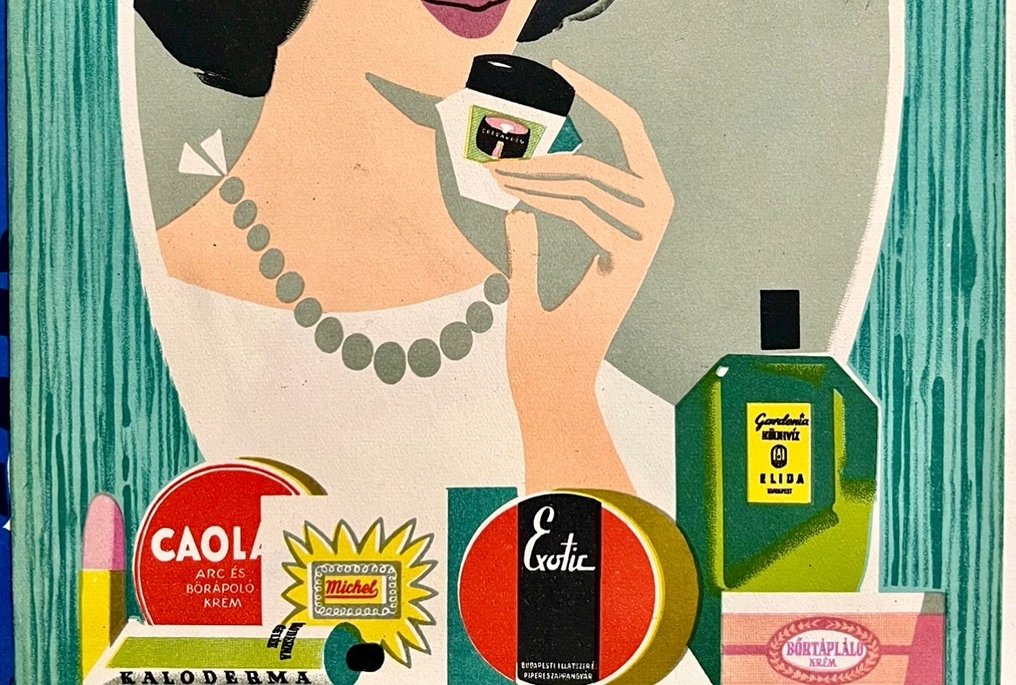
NO RESERVE PRICE - Beautiful Quartz Crystal Cluster on a custom stand - Height: 21 cm - Width: 10 cm- 2500 g - (1)
Catawiki is continuously updating its technology. You are currently using an outdated browser. To optimise your browsing experience, please update your browser.
You can set your cookie preferences using the toggles below. You can update your preferences, withdraw your consent at any time, and see a detailed description of the types of cookies we and our partners use in our Cookie Policy.
No. 83916709





Tram poster is a rarity genre in the devlopment of poster art. It was mostly wide spread in Hungary and also, but less frequently, in other Center/Easter European countries before the collapse of the Soviet Union where tram as public transport was commonly used by citizens in cities.
The tram posters are true personalities: sort of English ladies among the advertising spaces. This small advertising type spread from Germany in the 1920s and soon became a constant feature on Budapest trams as well. Inspired by a German example, a separate space was created inside the tram cars for their placement, on the inclined surfaces between the windows and the ceiling.
Last Picture: The appearance of tram posters coincided with the golden age of Hungarian poster art: the interior of trams featured works by numerous renowned artists.
Alongside various commercial messages, educational topics often found their place, drawing attention to civilized or safe travel practices, especially needed in the post-war period due to overcrowded, poorly maintained trains, and undisciplined passengers leading to many accidents.
Providing high visibility, tram posters were excellent for spreading propaganda messages from the beginning. In the 1950s and 60s, following the spirit of Soviet cultural policy, numerous posters were created, but commercial messages gradually displaced them from passenger spaces.
—
Mészáros András
1922 - 2007
András Mészáros (Budapest, April 8, 1922 - Budapest, October 19, 2007) was a Hungarian poster designer, cartoonist, graphic & book illustrator.
He graduated from the School of Fine and Applied Arts. He worked as an advertising graphic artist from 1943-57. He designed movie and political propaganda posters. He was a member of Nepszava between 1949 and 1955, and during this period he also headed the decoration department of SZOT.
Between 1957 and 1992, he was a cartoonist at Nepszabadsag, where he had a permanent column titled Our Weekly Drawn Commentary from 1960-1990, and once a week, a column titled Letterhead. He has published more than 10,000 drawings in domestic and foreign magazines, books and cartoon albums. Ludas Matyi regularly published his cartoons between 1957 and 1990. From 1965 his drawings were regularly published once a week in the German-language Budapest Rundschau, under the heading Mitten am Rande.
—
About Hungarian Poster Art
Hungarian poster art has long been celebrated for its unique and captivating style, making it a significant cultural and artistic movement in the world. From the late 19th century to the present day, Hungarian poster art has left an indelible mark on the global art scene, with its innovative techniques, bold designs, and powerful messages.
One of the highlights of Hungarian poster art is its ability to seamlessly blend various artistic styles and influences. The movement drew inspiration from a wide range of sources, including Art Nouveau, Constructivism, and Surrealism, resulting in a diverse and eclectic body of work. Artists such as Mihály Bíró, József Bottlik, and István Irsai pushed the boundaries of traditional poster design, experimenting with typography, color, and composition to create visually striking and thought-provoking pieces.
Another notable aspect of Hungarian poster art is its emphasis on storytelling and narrative. Unlike many other countries' posters, which primarily served as advertising tools, Hungarian posters often conveyed a deeper meaning or social commentary. They were not just meant to sell products but also to engage viewers intellectually and emotionally. This storytelling approach allowed Hungarian poster art to transcend its commercial purpose and become a powerful medium for social and political expression.
The importance of Hungarian poster art in the world cannot be overstated. During the early 20th century, Hungary was at the forefront of graphic design, and its posters gained international recognition and acclaim. The Budapest School, a group of Hungarian artists, revolutionized the field with their avant-garde approach, influencing poster art movements across Europe and beyond. Their innovative techniques and artistic vision set new standards for poster design, inspiring generations of artists worldwide.
Furthermore, Hungarian poster art played a crucial role in shaping public opinion and mobilizing society. In times of political turmoil and social change, posters became a powerful tool for propaganda and activism. During World War II and the Hungarian Revolution of 1956, posters were used to rally support, convey messages of resistance, and document historical events. The ability of Hungarian artists to capture the spirit of the times and communicate complex ideas through visual imagery made their posters an integral part of the nation's cultural and political identity.
Today, Hungarian poster art continues to thrive, with contemporary artists carrying on the legacy of their predecessors. The Hungarian Poster Museum in Budapest showcases the rich history and evolution of this art form, attracting visitors from around the world. The enduring appeal and influence of Hungarian poster art can be seen in the works of renowned artists like Tibor Helényi and István Orosz, who have successfully merged traditional techniques with modern aesthetics.
In conclusion, Hungarian poster art stands as a testament to the country's artistic prowess and cultural heritage. Its unique style, emphasis on storytelling, and ability to provoke thought and emotion have made it an important and influential movement in the world. From its early beginnings to the present day, Hungarian poster art continues to captivate audiences and inspire artists, leaving an indelible mark on the global art scene.
—
Please note that our company was founded in 1994 and it is internationally trackable. Invoice is available upon request.
Our team consists of members with university degree of art, painting valuation experts and experienced art&antique dealers
Feel free to ask as much as you want. Lifetime warranty is available for all items originality.
Shipping is with insurance.
Tram poster is a rarity genre in the devlopment of poster art. It was mostly wide spread in Hungary and also, but less frequently, in other Center/Easter European countries before the collapse of the Soviet Union where tram as public transport was commonly used by citizens in cities.
The tram posters are true personalities: sort of English ladies among the advertising spaces. This small advertising type spread from Germany in the 1920s and soon became a constant feature on Budapest trams as well. Inspired by a German example, a separate space was created inside the tram cars for their placement, on the inclined surfaces between the windows and the ceiling.
Last Picture: The appearance of tram posters coincided with the golden age of Hungarian poster art: the interior of trams featured works by numerous renowned artists.
Alongside various commercial messages, educational topics often found their place, drawing attention to civilized or safe travel practices, especially needed in the post-war period due to overcrowded, poorly maintained trains, and undisciplined passengers leading to many accidents.
Providing high visibility, tram posters were excellent for spreading propaganda messages from the beginning. In the 1950s and 60s, following the spirit of Soviet cultural policy, numerous posters were created, but commercial messages gradually displaced them from passenger spaces.
—
Mészáros András
1922 - 2007
András Mészáros (Budapest, April 8, 1922 - Budapest, October 19, 2007) was a Hungarian poster designer, cartoonist, graphic & book illustrator.
He graduated from the School of Fine and Applied Arts. He worked as an advertising graphic artist from 1943-57. He designed movie and political propaganda posters. He was a member of Nepszava between 1949 and 1955, and during this period he also headed the decoration department of SZOT.
Between 1957 and 1992, he was a cartoonist at Nepszabadsag, where he had a permanent column titled Our Weekly Drawn Commentary from 1960-1990, and once a week, a column titled Letterhead. He has published more than 10,000 drawings in domestic and foreign magazines, books and cartoon albums. Ludas Matyi regularly published his cartoons between 1957 and 1990. From 1965 his drawings were regularly published once a week in the German-language Budapest Rundschau, under the heading Mitten am Rande.
—
About Hungarian Poster Art
Hungarian poster art has long been celebrated for its unique and captivating style, making it a significant cultural and artistic movement in the world. From the late 19th century to the present day, Hungarian poster art has left an indelible mark on the global art scene, with its innovative techniques, bold designs, and powerful messages.
One of the highlights of Hungarian poster art is its ability to seamlessly blend various artistic styles and influences. The movement drew inspiration from a wide range of sources, including Art Nouveau, Constructivism, and Surrealism, resulting in a diverse and eclectic body of work. Artists such as Mihály Bíró, József Bottlik, and István Irsai pushed the boundaries of traditional poster design, experimenting with typography, color, and composition to create visually striking and thought-provoking pieces.
Another notable aspect of Hungarian poster art is its emphasis on storytelling and narrative. Unlike many other countries' posters, which primarily served as advertising tools, Hungarian posters often conveyed a deeper meaning or social commentary. They were not just meant to sell products but also to engage viewers intellectually and emotionally. This storytelling approach allowed Hungarian poster art to transcend its commercial purpose and become a powerful medium for social and political expression.
The importance of Hungarian poster art in the world cannot be overstated. During the early 20th century, Hungary was at the forefront of graphic design, and its posters gained international recognition and acclaim. The Budapest School, a group of Hungarian artists, revolutionized the field with their avant-garde approach, influencing poster art movements across Europe and beyond. Their innovative techniques and artistic vision set new standards for poster design, inspiring generations of artists worldwide.
Furthermore, Hungarian poster art played a crucial role in shaping public opinion and mobilizing society. In times of political turmoil and social change, posters became a powerful tool for propaganda and activism. During World War II and the Hungarian Revolution of 1956, posters were used to rally support, convey messages of resistance, and document historical events. The ability of Hungarian artists to capture the spirit of the times and communicate complex ideas through visual imagery made their posters an integral part of the nation's cultural and political identity.
Today, Hungarian poster art continues to thrive, with contemporary artists carrying on the legacy of their predecessors. The Hungarian Poster Museum in Budapest showcases the rich history and evolution of this art form, attracting visitors from around the world. The enduring appeal and influence of Hungarian poster art can be seen in the works of renowned artists like Tibor Helényi and István Orosz, who have successfully merged traditional techniques with modern aesthetics.
In conclusion, Hungarian poster art stands as a testament to the country's artistic prowess and cultural heritage. Its unique style, emphasis on storytelling, and ability to provoke thought and emotion have made it an important and influential movement in the world. From its early beginnings to the present day, Hungarian poster art continues to captivate audiences and inspire artists, leaving an indelible mark on the global art scene.
—
Please note that our company was founded in 1994 and it is internationally trackable. Invoice is available upon request.
Our team consists of members with university degree of art, painting valuation experts and experienced art&antique dealers
Feel free to ask as much as you want. Lifetime warranty is available for all items originality.
Shipping is with insurance.








